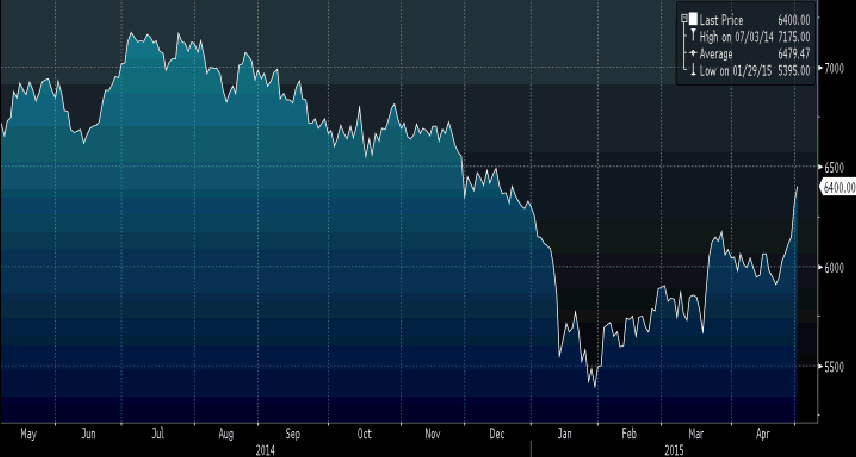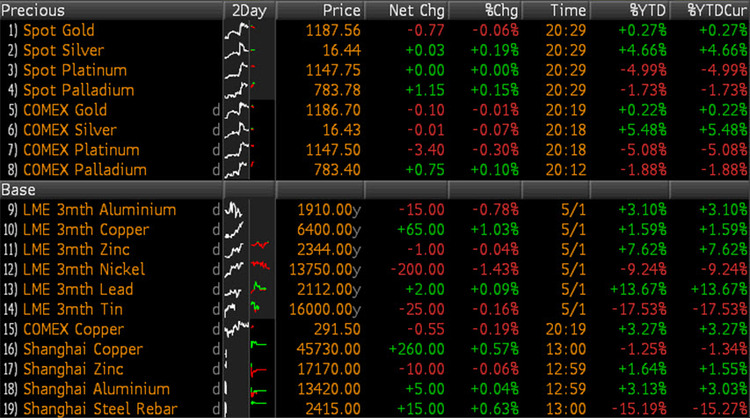Burned rotor from a copperiferous elektro motor
Given the importance of copper as a proxy for global economic growth, the recent rebound in the metal may indicate signs of a bottom. The chart below shows the recent price performance with copper up 18% from its low earlier this year of $2.45 per pound.

Source: Bloomberg
Very few commodities can match this rebound and therefore further study is warranted. Despite the seemingly endless amount of news regarding subpar economic growth, I think it’s important to remember that there is at least growth to speak of with 3% GDP growth the current “norm”. So if global growth and copper usage go hand-in-hand, the idea of a secular bull market for the metal must at least be considered.

Source: Bloomberg
This is debatable but there are several reasons why this makes sense. First, the major copper producers of the world arenÂ’t flooding markets in the same way that iron ore producers are. It appears that the copper market is relatively evenly matched between supply and demand and single news items (like floods in Chile or tax increases in Zambia) can produce a rather pronounced swing in the supply demand balance in the near term. As an example, the International Copper Study Group (ICSG) reported a 59,000 tonne surplus of refined copper in January 2015, the most recent data available. This is in the wake of repeated monthly copper deficits throughout 2014.
Second, while the Chinese economy does indeed appear to be moderating, any sustained news of a “slowdown” could paradoxically boost copper demand through Chinese officials taking measures to stimulate economic growth. China’s PMI data is one of many Chinese data points which we monitor. A reading below 50 indicates economic contraction while anything above 50 indicates economic expansion. I am fully aware of the questionable validity of Chinese economic statistics and would advocate looking at much more data (which I do), but the PMI data is a reasonable single data point.

More stimulus could be supportive of the copper price going forward. This is important as China consumes 40% of global copper production and has based much of its economic growth on the real estate sector – crucial for copper.
Third, urbanization and technological advancement (two themes we remain bullish on over the long term) are powerful forces to halt. If vehicle electrification ever takes hold to become 10% of the global automotive fleet, this would require an additional 1 million tonnes of copper on global markets every year. Though data is tough to pin down, a full electric vehicle requires around 165 pounds of copper. Add in hybrids, plug in electric vehicles, busses, etc and you can see how automotive growth underpins the secular bull case for copper. This, of course, ignores growth in traditional automotive demand as well as infrastructure. This additional million tonnes is the approximate equivalent of one new Escondida. While this penetration is not imminent (perhaps a decade under the most bullish scenario), it does give you an idea of how “new” uses for copper need to be factored into future demand forecasts. The lithium ion battery business is approximately $18 billion in size today and forecast to grow to $75 billion by 2020. This is impressive for a number of reasons, not the least of which is the fact that the entire rechargeable battery business globally is only $50 billion in size today according to Navigant. Clearly, more than just lithium, cobalt, etc will be needed to achieve these projections. Copper is at the center of this growth.
Fourth, head grades appear to be falling and mining costs, in general, are increasing. BHP Billiton (BHP: NYSE) stated earlier this year that grades at their Escondida mine will fall by 24% in FY2016 which will impact results in the near term until productivity measures, already underway, will increase throughput and production. Anglo American (AAL:LON) has raised similar concerns with grade declines and variability at their Los Bronces mine in Chile. Clearly, investing in productivity is only going to increase in importance. While much of the global copper cost curve is profitable at current prices (approximately 90% according to industry data with 50% still profitable at approximately $1.60), any sustained supply disruptions will require a higher copper price to incentivize capital expenditures and hence new supply.
The Fatal Conceit
Predicting commodity prices has widely been viewed as a “fatal conceit” to steal a phrase from Friedrich Hayek and that’s not what this note is aiming to do. Any rational observer could agree, though, that the rout in the copper price appears somewhat overdone. While the major copper producers focus on organic growth and balance sheet strength by leveraging productivity, the steady demand for copper remains in place. Going forward, a close study of copper grades, copper inventories, and GDP growth are crucial as these metrics have historically been the drivers of the price of copper. Additionally, copper is no different from any other commodity in that the lowest cost producer always wins. For this reason, we remain focused on two types of companies in the copper space: low cost producers who can generate substantial free cash flow and companies with an acquisition strategy of consolidating high quality assets at a low relative cost such as Copperbank Resources (CBK:CSE).
Chris Berry
President of House Mountain Partners LLC and Co-Editor of Disruptive Discoveries Journal
Chris Berry is a well-known writer, speaker, and analyst. He focuses much of his time on Energy Metals – those metals or minerals used in the generation or storage of energy. He is a student of the theory of Convergence emanating from the Emerging World and believes it will have profound effects across the globe in the coming years. Active on the speaking circuit throughout the world and frequently quoted in the press, Chris spent 15 years working across various roles in sales and brokerage on Wall Street before shifting focus and taking control of his financial destiny.He is also a Senior Editor at Investor Intel. He holds an MBA in Finance with an international focus from Fordham University, and a BA in International Studies from The Virginia Military Institute. Please visit www.discoveryinvesting.com and www.house-mountain.com for more information and registration for free newsletter as well as his disclaimer.
